#unable to write about reincarnation and themes of identity
Explore tagged Tumblr posts
Text
Ohhhhh this is gonna be sci-fi HORROR isn’t it
#we burn worlds#unable to write about reincarnation and themes of identity#without bein spooky about it#the team just shot a dude in the face#who was either just some random monk who wanted to kill them#or the dude who should have dead ages ago#or maybe the main character is just under stress?#or maybe the alien megastructure they’re all inside is messing with their head#and I don’t know which answer is less reassuring
6 notes
·
View notes
Photo

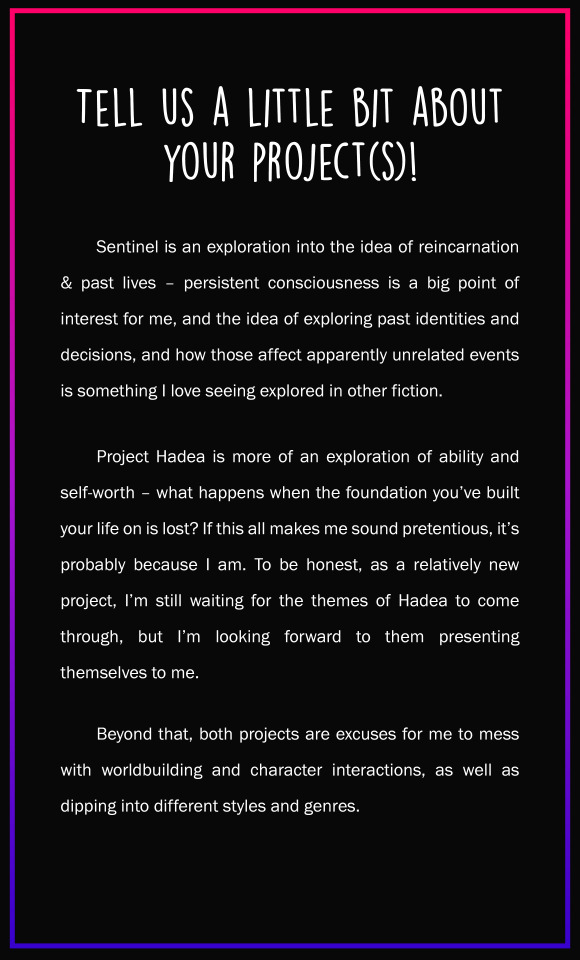
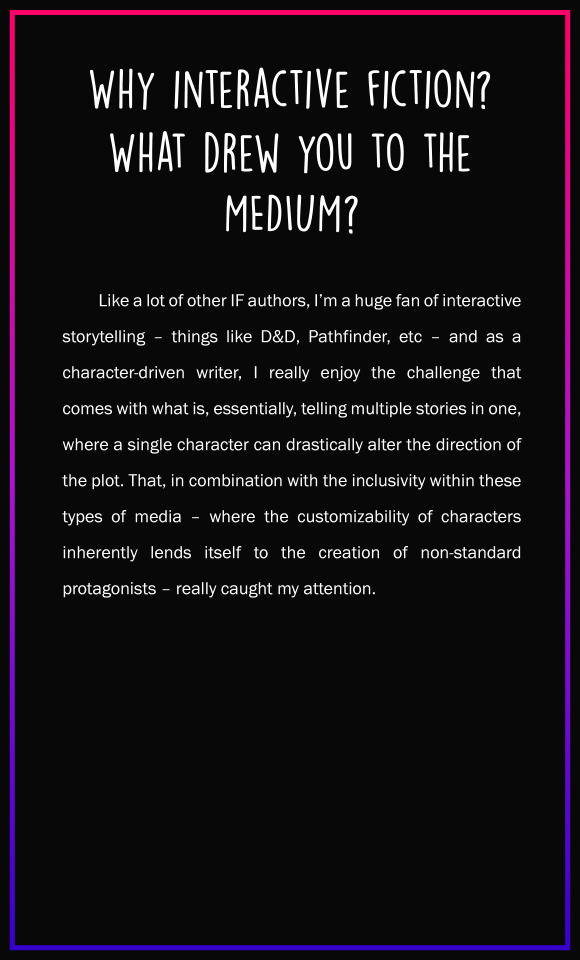


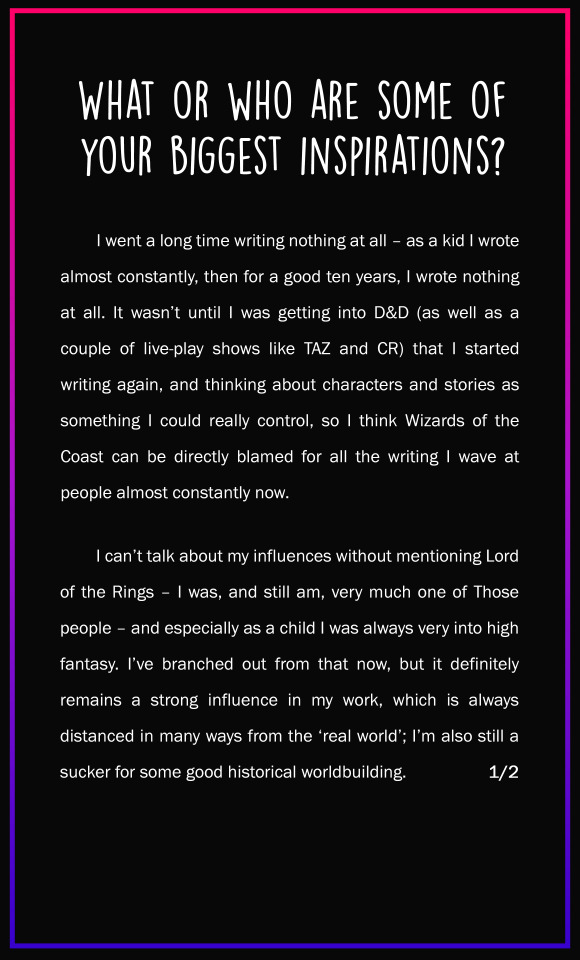
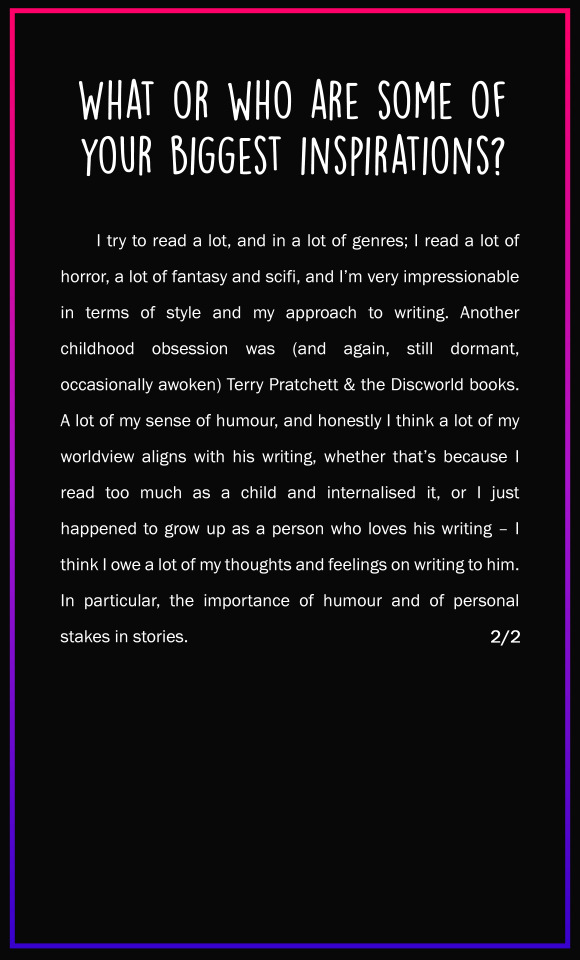
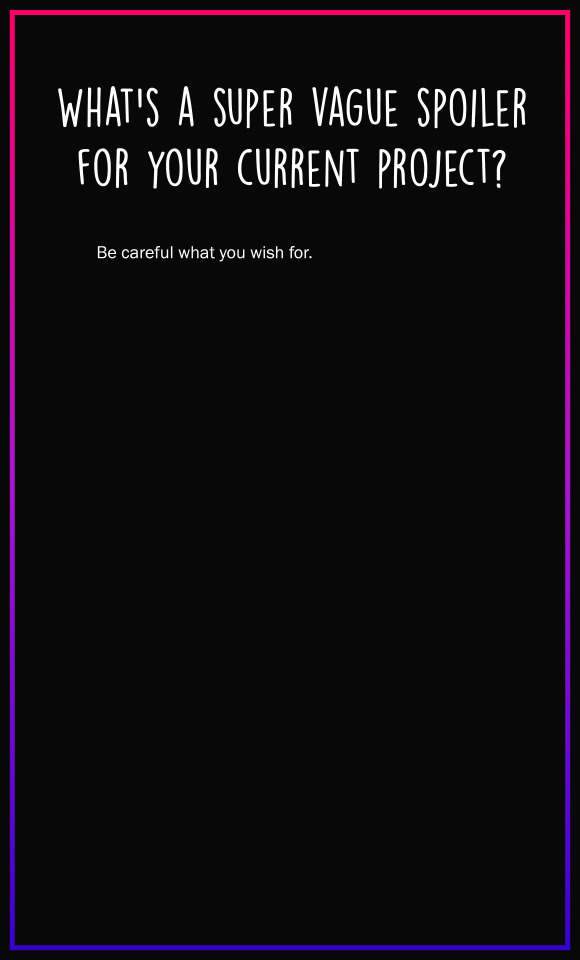
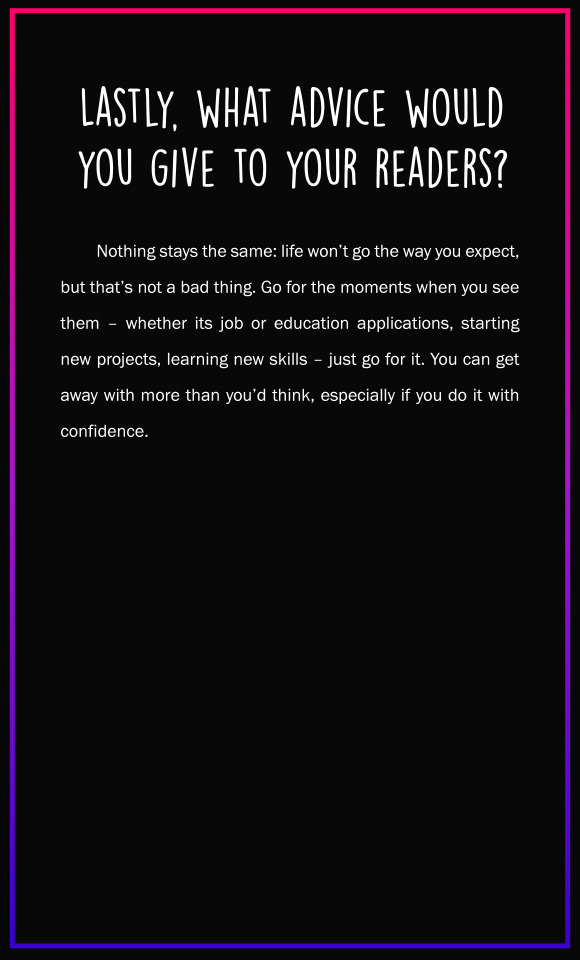
Day 6 of Pride Month interviews! Up next we’ve got the wonderful Nyehilism!
Nyehilism, author of Sentinel
Pride Month Featured Author
You’re frozen, unable to move as you meet bloodshot eyes.
You can’t breathe, can’t think. There’s an awful familiarity, and for just a moment, you feel like you’re looking in a mirror, your warped reflection snarling back at you.
Then there’s a crack, loud enough to break the spell, and the monster s c r e a m s.
A brutal murder rocks the balance of your life. An old friend is lying to you, and a stranger knows more than he’s telling. You dream of people and places you’ve never seen, of flowers and buildings and vast strange skies - and during the day, you’re hunted by a creature like nothing you’ve seen before. We all have demons, but you hadn’t expected yours to follow you through death.
Your past has caught up with you, and it has teeth.
Demo: Sentinel, Project Hadea
Tags for Sentinel: urban fantasy, horror
Tags for Project Hadea: sci-fi, +18
(INTERVIEW TRANSCRIPT UNDER THE CUT!)
Q1: Tell us a little bit about your project(s)!
Sentinel is an exploration into the idea of reincarnation & past lives – persistent consciousness is a big point of interest for me, and the idea of exploring past identities and decisions, and how those affect apparently unrelated events is something I love seeing explored in other fiction.
Project Hadea is more of an exploration of ability and self-worth – what happens when the foundation you’ve built your life on is lost? If this all makes me sound pretentious, it’s probably because I am. To be honest, as a relatively new project, I’m still waiting for the themes of Hadea to come through, but I’m looking forward to them presenting themselves to me.
Beyond that, both projects are excuses for me to mess with worldbuilding and character interactions, as well as dipping into different styles and genres.
Q2: Why interactive fiction? What drew you to the medium?
Like a lot of other IF authors, I’m a huge fan of interactive storytelling – things like D&D, Pathfinder, etc – and as a character-driven writer, I really enjoy the challenge that comes with what is, essentially, telling multiple stories in one, where a single character can drastically alter the direction of the plot. That, in combination with the inclusivity within these types of media – where the customizability of characters inherently lends itself to the creation of non-standard protagonists – really caught my attention.
Q3: Are your characters influenced by your identity? How?
My characters are almost entirely bisexual, and the ones that aren’t are some flavour of LGBT+. I don’t know how much more I can say, honestly: I’m so far gone at this point I tend to forget it’s possible to create heterosexual characters. I think in more general terms, a lot of my characters tend to take very... pragmatic? Approaches to gender and sexuality, as influenced by my own experience: I’ve always known I’m not straight, and while it’s an inherent part of my identity, I don’t think about it much.
Q4: What would you like to see more of in LGBT+ fiction?
Honestly, any and everything. More wlw, more nblw/m, more interracial non-cishet relationships, more open acknowledgement of character’s sexuality. In particular, I’d like to see more bisexual characters who are openly bisexual, without using cutsey little phrases to dance around the word. Bisexual characters in both different- and same-gender relationships, where their bisexuality is still knowledged and accepted.
Also, more non-binary characters, characters exploring and changing their identities throughout the course of the story and it not being a big deal.
Q5: What or who are some of your biggest inspirations?
I went a long time writing nothing at all – as a kid I wrote almost constantly, then for a good ten years, I wrote nothing at all. It wasn’t until I was getting into D&D (as well as a couple of live-play shows like TAZ and CR) that I started writing again, and thinking about characters and stories as something I could really control, so I think Wizards of the Coast can be directly blamed for all the writing I wave at people almost constantly now.
I can’t talk about my influences without mentioning Lord of the Rings – I was, and still am, very much one of Those people – and especially as a child I was always very into high fantasy. I’ve branched out from that now, but it definitely remains a strong influence in my work, which is always distanced in many ways from the ‘real world’; I’m also still a sucker for some good historical worldbuilding.
I try to read a lot, and in a lot of genres; I read a lot of horror, a lot of fantasy and sci-fi, and I’m very impressionable in terms of style and my approach to writing. Another childhood obsession was (and again, still dormant, occasionally awoken) Terry Pratchett & the Discworld books. A lot of my sense of humour, and honestly I think a lot of my worldview aligns with his writing, whether that’s because I read too much as a child and internalised it, or I just happened to grow up as a person who loves his writing – I think I owe a lot of my thoughts and feelings on writing to him. In particular, the importance of humour and of personal stakes in stories.
Q6: What’s a super vague spoiler for your current project?
Be careful what you wish for.
Q7: Lastly, what advice would you give to your readers?
Nothing stays the same: life won’t go the way you expect, but that’s not a bad thing. Go for the moments when you see them – whether its job or education applications, starting new projects, learning new skills – just go for it. You can get away with more than you’d think, especially if you do it with confidence.
#if: events#Pride Month 2021#pride month#queer authors#queer creators#queer fiction#interactive fiction
93 notes
·
View notes
Photo

[ID: A chart describing the core values of each of the nine Enneagram personality types with YuGiOh characters correlated to each of the types.]
YuGiOh Enneagram Analysis, Part #1
Please note that this is the “boring” informational post about Enneagram with the Types listed and explained as well as a few other things. The next post is what has the actual, in-depth character profiles promised!
Introduction & Motivation
Over the past several months, I have been trying to analyze my strengths and weaknesses as a writer and learn more. I have been writing fanfiction since I was a little kid, making my first FF.net account in 2003 when I would have been twelve years old. Even before that, I was a lurker and wrote fics to share with my childhood best friend on paper or floppy discs.
YuGiOh came into my life at some point shortly thereafter. I know this, because I spent my thirteenth birthday in a comic book shop, mostly watching some of my male friends play the trading card game. I had some of the cards, but I was never much of a player, unable to keep up with the seemingly rapid rule changes. Besides that, I was always way more interested in the story and characters than I was in the card game. I remember I even wanted to call “YuGiOh cards” “Duel Monsters” instead to make it seem a little closer to tween-y LARPing.
Eventually, I gave up on collecting cards or trying to ply the game. I felt that while my male friends didn’t mind me being around when they played, they weren’t extremely interested in helping me learn or keep up. I felt I had other strengths, so I started carrying around a notebook even more than I already did. I started my fledgling forays into online fandom. And YuGiOh was a big part of the beginning of that.
I can’t remember posting any YuGiOh fic in particular, and I’m sure that if I had it would make me cringe now. What I do remember is reading some and also spending a lot of time lying on my bed, headphones plugged into a small purple stereo, listening to the first of the two American-released CDs with YuGiOh-inspired music on them. In particular, the last three tracks were pieces of music from the original score composed for the 4Kids dub, which is - for some reason - different from the original Japanese music.
During that time, I would fantasize and conjure my own YuGiOh plots in my head, most of which were focused on the Ancient Egyptian and more spooky, spiritual, and horror themes in the show. I was really fascinated with the reincarnation angle, though my understanding of and opinions on how that works have grown with time.
Years went by, and I didn’t think about YuGiOh much at all. Then, something happened in 2018. I don’t know what got in my head, but it was like all the joy I once found in thinking about the YuGiOh characters came back in a giddy conversation with my childhood best friend. Then, for a little while, it wouldn’t leave me alone.
I started writing for the fandom then, and after several detours, I’m trying to get back in the groove of it.
My approach to the tone of YuGiOh-fanning is that it’s a bit serious, but it’s also with a tongue placed in my cheek because of how incomprehensible or silly the plot can be on a meta level. Sometimes, it almost brings tears to my eyes by being so over-the-top about something that, in the real world, would make no sense at all. But the drama, in the context of the universe, somehow rings true.
I think that’s all owing to how most of the primary characters are just... really freaking great characters.
It has often puzzled me. Like, did Takahashi do all this layering on purpose? Is it really there, or did earnest fanon just make it seem like it? And, as a person, I am always here for a good fan-and-canon symbiosis.
This post is going to be, from here on, an effort to match the YuGiOh characters to the 9 Enneagram Personality Types. I am writing this for my own benefit as I continue to work on my pet YuGiOh fanfiction project, It’s Always Sunny in Domino City, which is a mixture of YGOTAS-vibes-and-concepts taken seriously and a sincere take on fanfiction for the actual canon. It’s dramedy about a sizeable chunk of the main cast a few years post-canon with some canon divergence such as the Memory World arc not yet and possibly never-happening. If that sounds like something you’d like, I would humbly request you check it out!
Either way, this will be an in-depth character analysis cheatsheet for all of the characters above, based on my observations, opinions, and feelings. I invite discussion, but it’s fine if we need to agree to totally disagree!
If you are interested and enjoy what’s below the Read More and in the coming second post, then you are welcome to utilize the character analyses to aid you in your own fanwork!
Enneagram
What is Enneagram, and why am I using it?
Enneagram is a personality categorization system that one might compare to the somewhat better-known MBTI. However, in the words of excellent writing-advice YouTuber, Abbie Emmons:
MBTI shows us how we behave.
Enneagram shows us what we believe.
I will be referencing Abbie’s video Using The ENNEAGRAM To Write CONFLICTED CHARACTERS and her free Enneagram-cheatsheet, available in the description of the linked video. Whether it’s before you continue reading or after, if you’re interested in writing, I would highly recommend you check out her channel!
The Enneagram system has nine basic personality types that overlap and interact in really interesting ways. It is not a hard science, and it’s not a horoscope. Instead, it’s supposed to be “based on conventional wisdom and modern psychology.” All I can say is that with every set of characters I’ve tried it with, it works! Once you get the hang of it, it feels kind of like ~✰~magic~✰~!
Below, I will list Abbie’s simplified definitions of each of the personality types, in order:
Type 1: The Reformer
The Rational, Idealistic Type:
Principled, Purposeful, Self-Controlled, and Perfectionistic
Basic Fear: Of being corrupt/evil, defective
Basic Desire: To be good, to have integrity, to be balanced
Key Motivations: Want to be right, to strive higher and improve everything, to be consistent with their ideals, to justify themselves, to be beyond criticism so as not to be condemned by anyone.
Type 2: The Helper
The Caring, Interpersonal Type:
Generous, Demonstrative, People-Pleasing, and Possessive
Basic Fear: Of being unwanted, unworthy of being loved
Basic Desire: To feel loved
Key Motivations: Want to be loved, to express their feelings for others, to be needed and appreciated, to get others to respond to them, to vindicate their claims about themselves.
Type 3: The Achiever
The Success-Oriented, Pragmatic Type:
Adaptable, Excelling, Driven, and Image-Conscious
Basic Fear: Of being worthless
Basic Desire: To feel valuable and worthwhile
Key Motivations: Want to be affirmed, to distinguish themselves from others, to have attention, to be admired, and to impress others.
Type 4: The Individualist
The Sensitive, Introspective Type:
Expressive, Dramatic, Self-Absorbed, and Temperamental
Basic Fear: That they have no identity or personal significance
Basic Desire: To find themselves and their significance (to create an identity)
Key Motivations: Want to express themselves and their individuality, to create and surround themselves with beauty, to maintain certain moods and feelings, to withdraw to protect their self-image, to take care of emotional needs before attending to anything else, to attract a "rescuer."
Type 5: The Investigator
The Intense, Cerebral Type:
Perceptive, Innovative, Secretive, and Isolated
Basic Fear: Being useless, helpless, or incapable
Basic Desire: To be capable and competent
Key Motivations: Want to possess knowledge, to understand the environment, to have everything figured out as a way of defending the self from threats from the environment.
Type 6: The Loyalist
The Committed, Security-Oriented Type:
Engaging, Responsible, Anxious, and Suspicious
Basic Fear: Of being without support and guidance
Basic Desire: To have security and support
Key Motivations: Want to have security, to feel supported by others, to have certitude and reassurance, to test the attitudes of others toward them, to fight against anxiety and insecurity.
Type 7: The Enthusiast
The Busy, Variety-Seeking Type:
Spontaneous, Versatile, Acquisitive, and Scattered
Basic Fear: Of being deprived and in pain
Basic Desire: To be satisfied and content—to have their needs fulfilled
Key Motivations: Want to maintain their freedom and happiness, to avoid missing out on worthwhile experiences, to keep themselves excited and occupied, to avoid and discharge pain.
Type 8: The Challenger
The Powerful, Dominating Type:
Self-Confident, Decisive, Willful, and Confrontational
Basic Fear: Of being harmed or controlled by others
Basic Desire: To protect themselves (to be in control of their own life and destiny)
Key Motivations: Want to be self-reliant, to prove their strength and resist weakness, to be important in their world, to dominate the environment, and to stay in control of their situation.
Type 9: The Peacemaker
The Easygoing, Self-Effacing Type:
Receptive, Reassuring, Agreeable, and Complacent
Basic Fear: Of loss and separation
Basic Desire: To have inner stability, "peace of mind"
Key Motivations: Want to create harmony in their environment, to avoid conflicts and tension, to preserve things as they are, to resist whatever would upset or disturb them.
Now that you’ve seen all those, what do you think your favorite character is? In YuGiOh or anything else! It works great for original characters and even yourself and your loved ones.
The actual Character Profiles will be in coming post(s), but continue reading if you want me to explain more about how and why the Enneagram is a great personality typing system. #nonspon, or whatever.
The Enneagram Chart
Now, you could just go to the Enneagram Institute’s page on How the System Works, but below I’ll cut it down to only the parts I’m interested in and explain those in a way that helps me.
Unlike in astrology or MBTI, which are both more restrictive in different ways, the relative position of each type matters a bit on the Enneagram chart, because it can be used to visualize a lot of things about a person!
The Basic Chart
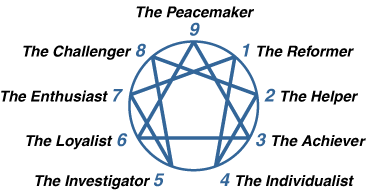
The Types are shown in a clockwise fashion with “1″ in the 1 o’clock position on an analog clock. The interior lines mean things, but I have trouble reading it without further delineation.
Centers of Response
Below are two small charts, displayed side-by-side. (If it’s too small, try right-click, open in new tab!)
The chart on the left shows the three “centers.” The “centers” indicate the first ‘processing language’ a person would use to respond to stimuli.
Type 8, Type 9, and Type 1 respond first based on instinct (primal, gut-feeling). If you want to go Freudian, this is from the id.
Type 2, Type 3, and Type 4 respond first based on feelings (social or personal desires, the heart). If you want to go Freudian, this is from the ego.
Type 5, Type 6, and Type 7 respond first based on thoughts (analytical rather than emotional, the head). If you want to go Freudian, this is from the superego.
Remember that, of course, every single type and person engages their instincts, their emotions, and their thoughts at different times and to different degrees, and some of these are learned or changed behaviors. This is about what their innate drive toward that would be.
Likewise, the same “centers” can also be used for the chart on the right. You will notice that all three of these are defined by what is typically considered a negative emotion. This is because this is about a person’s instinctive, not particularly conscious emotional response when they are backed into a corner and deprived of something that is core to the needs of their personality type.
Type 8, Type 9, and Type 1 tend to respond to a threat to their psychic well-being with anger/rage.
Type 2, Type 3, and Type 4 tend to respond to a threat to their psychic well-being with shame.
Type 5, Type 6, and Type 7 tend to respond to a threat to their psychic well-being with fear.

Stress vs. Growth
We all know that there are times when a person isn’t acting like themselves, for better or for worse. Usually, “You’re not acting like yourself,” means that a person is behaving badly. Of course, it’s way easier to withdraw and bristle and defend rather than growing in the midst of adversity. However, it is certainly possible to experience character growth in response to experiences, good and bad. Unlike a lot of other personality typing schemes, the Enneagram has a way to display and predict what stress and growth do to a person.
The Enneagram never suggests that any Type is an island unto itself. Every person contains multitudes, but a person’s Type is likely to remain relatively stable throughout their lives, once they have had a chance to develop any personality at all. This means that when a person is stressed or growing that they do not become the type they emulate. Rather, they are more highly expressing that aspects of their personality that reflect those drives and desires but in a way that is either fraught, sickly, or unwell (in the case of stress), or aspirational, flying-high, and incorporating the hard-lessons into who a person is going to be going forward (in the case of growth). The latter, especially, isn’t a sustainable mode, while a stressed person can become more entrenched in their bad habits and defensive coping mechanisms.
Stress
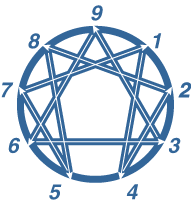
Note the white, directional arrows. Each number has an arrow point pointing to it and an arrow leading away from it. The point indicates that this is the stress manifestation for the Type at the origin of that arrow. The origin of each arrow indicates the Type being described.
Confused? Let me finally give you a YuGiOh example.
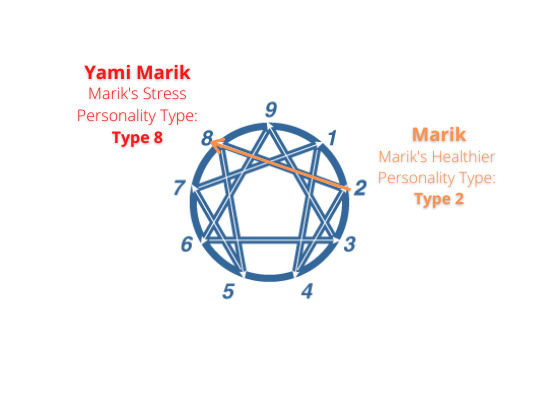
When I was trying to identify the Types of the characters, defining Marik was difficult, because he has a “Yami,” or Dark Side, which has its own personality and will but which is not its own separate soul or person than Marik himself. Rather, it’s a kind of fantasy/magic-assisted personality splintering where Yami Marik is a full manifestation of the negative traits Marik needed to embody to survive.
So, for reference:
When stressed, Type 1 behaves more like Type 4.
When stressed, Type 2 behaves more like Type 8.
When stressed, Type 3 behaves more like Type 9.
When stressed, Type 4 behaves more like Type 2.
When stressed, Type 5 behaves more like Type 7.
When stressed, Type 6 behaves more like Type 3.
When stressed, Type 7 behaves more like Type 1.
When stressed, Type 8 behaves more like Type 5.
When stressed, Type 9 behaves more like Type 6.
Alternatively, you can use these sequences to follow the stress lines:
1-4-2-8-5-7-1
9-6-3-9
Growth
Think of the above-explanation in reverse.
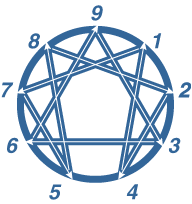
The sequence:
1-7-5-8-2-4-1
9-3-6-9
As a Type 1 grows, they incorporate more positive traits of Type 7.
As a Type 2 grows, they incorporate more positive traits of Type 4.
As a Type 3 grows, they incorporate more positive traits of Type 6.
As a Type 4 grows, they incorporate more positive traits of Type 1.
As a Type 5 grows, they incorporate more positive traits of Type 8.
As a Type 6 grows, they incorporate more positive traits of Type 9.
As a Type 7 grows, they incorporate more positive traits of Type 5.
As a Type 8 grows, they incorporate more positive traits of Type 2.
As a Type 9 grows, they incorporate more positive traits of Type 3.
Wings
The final thing to know about the Enneagram chart for my purposes is about wings. The wing of your personality traits accounts for the complementary and contradictory aspects of your personality. They are the inconsistencies that make you human, predicted and jumped in. Typically, a person is not thought to have both possible wings but one or the other. A wing is one of the two adjacent Types to yours, the number before, or the number after, and it is annotated, for example:
Type 1, Wing 2: 1w2
Type 1, Wing 9: 1w9
Link to Part 2 Here!
#yugioh#yugi mutou#seto kaiba#jounouchi katsuya#yugioh duel monsters#mutou yugi#kaiba seto#kaiba mokuba#mokuba kaiba#kujaku mai#mai kujaku#anzu mazaki#mazaki anzu#katsuya jounouchi#marik ishtar#isis ishtar#rashid ishtar#hiroto honda#honda hiroto#ryou bakura#bakura ryou#yami bakura#yami marik#yami yugi#pharaoh atem#atem#ryuji otogi#otogi ryuji#main cast#op
38 notes
·
View notes